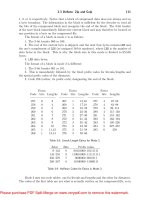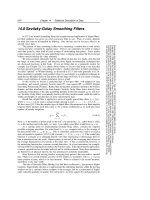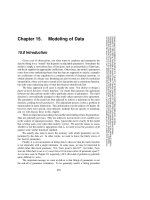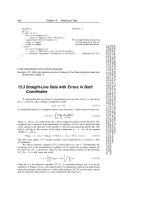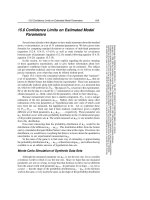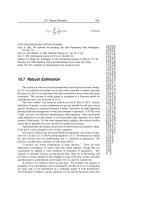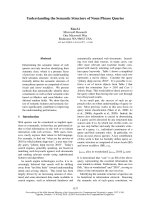THE FRACTAL STRUCTURE OF DATA REFERENCE- P3 pptx
Bạn đang xem bản rút gọn của tài liệu. Xem và tải ngay bản đầy đủ của tài liệu tại đây (46.18 KB, 5 trang )
List of Tables
3.1 Cache planning example: current storage subsystems. 45
in current storage. 45
same three applications. 45
Busiest 20
files
(data sets) in the case study.
3.2 Cache planning example: three applications contained
3.3 Cache planning example: target environment for the
4.1
54
Preface
For purposes of understanding its performance, a computer system is tradi
-
tionally viewed as a processor coupled to one or more disk storage devices, and
driven by externally generated requests (typically called transactions). Over
the past several decades, very powerful techniques have become available to the
performance analyst attempting to understand, at a high level, the operational
behavior of such systems.
Nevertheless, the ability of computers to rapidly deliver requested infor
-
mation, at the time it is needed, depends critically on an underlying structure
whose operational behavior is not nearly as well understood: the memory hi
-
erarchy through which data stored on disk is made available to the processor.
The memory hierarchy tends to consist of many levels, including one or more
processor buffer memories (also called
L1 and L2 cache), main processor mem
-
ory, disk storage cache memory? disk storage, and often tape. A given level is
usually configured to have both a much smaller storage capacity and a much
faster access time than the level below it. The data stored in each memory level
is managed dynamically, with new data being brought in as needed from the
level below.
The architectural concept of a memory hierarchy has been immensely suc
-
cessful, making possible today’s spectacular pace of technology evolution in
both the volume of data and the average speed of data access. As we shall find
in Chapter 1, however, its success is difficult to understand if we rely upon a
traditional performance modeling framework. This is because the power of a
memory hierarchy comes from its ability to take advantage of patterns of data
use that are transient. Repeated requests tend to be made to a given data item
over a short period of time, after which the data may remain unreferenced for
extended periods (or even indefinitely). Such patterns do not yield easily to an
analysis based upon steady
-
state, “memoryless” behavior.
This book adopts a heavy
-
tailed distribution for the time between requests
to a given data item: substantial probabilities are assigned even to very long
interarrival times. The probabilities are sufficiently high, and the corresponding
gaps between arrivals are sufficiently long, that the average time until the next
reference becomes unbounded. There is no steady
-
state arrival rate. This
xvi
modeling approach reflects the opposite of the usual steady
-
state assumptions:
arrivals are attributed to transient events, rather than to an ongoing arrival
process.
In a reflection of its emphasis on transient events, the proposed modeling
approach calls for a very high arrival probability during the time shortly after
a request. The probability then falls off rapidly, if no request occurs. This
results in a pattern of accesses characterized by short “bursts”, separated by
long periods of inactivity. By studying such transient “bursts”, we are able to
gain a practical understanding of memory hierarchy performance.
Heavy
-
tailed distributions are characteristic of fractal, or self
-
similar, phe
-
nomena. As discussed in Chapter 1, the presence of self
-
similarity in data
reference patterns should not be surprising; indeed, it would be reasonable to
anticipate it based upon the explicitly hierarchical nature of most software. To
reflect the inferred “behind the scenes” role of hierarchically structured soft
-
ware, we adopt, in Chapter 1, the term hierarchical reuse model to describe
the overall modeling framework which this book proposes. We also show that
the proposed heavy
-
tailed distribution provides an excellent approximation of
realistic interarrival times to individual data items.
Even without the arguments of Chapter 1, self
-
similar behavior would still
be plausible, or even likely. Such behavior has now been observed in many
aspects of data reference [ 1, 2, 3, 4, 5, 6, 7]. The pioneering work by Voldman,
Mandelbrot, and others [1], and later by Thiébaut [2], is particularly worth
noting, since it established that the sequence of locations referenced by software
tends to be structured in a self
-
similar manner. This fact certainly enhances
the plausibility of a self
-
similar relationship involving interarrival times to any
single, identified reference location.
Despite the importance of self
-
similar phenomena in describing the opera
-
tional behavior of computer systems, however, this preface is perhaps the place
to admit that the demonstration of one more example of such a phenomenon
is not, by itself, sufficiently interesting to justify an entire book. Instead, the
“meat” of the present book comes from the ability of the hierarchical reuse
model to impose a mathematically tractable structure on important problems
involving the operation and performance of a memory hierarchy. We shall
obtain striking insights into how such hierarchies work, and how to exploit
them to best advantage. The emphasis of the book will be on the practical
applications of such results.
The focus of the applications examined in this book is on the portion of a
computer system’s memory hierarchy that lies below the level of the “get” and
“put” statements issued by running software. This includes file buffer areas in
main processor memory, cache memory associated with the disk system, disk
storage, and tape when it is used as a repository for dynamic migration and
recall.
THE FRACTAL STRUCTURE OF DATA REFERENCE
Preface xvii
The primary audience intended for the book is the large body of workers
who endeavor to ensure that computer systems, and the associated disk storage,
are configured and managed so as to deliver the expected and desired level of
performance. This includes practitioners in the area of computer performance
management and capacity planning, as well as those who build tools to facilitate
their work.
To apply many of the ideas presented in this book, performance practitioners
will require some minimal level of storage subsystem performance reporting
(for example, measurements of cache hit ratios). On subsystems running
under the Operating System/390 (
OS/390) and Virtual Machine (VM) operating
systems, the needed reporting is universal and standardized. For this reason,
these environments are the main source of the case studies, empirical data, and
examples presented in the book. Performance practitioners working on the
Unix and Windows
NT platforms will also find, in many cases, that the needed
performance reporting can be obtained. Although it is not standardized across
storage vendors, vendors often offer such reporting as a differentiating feature.
As befits a work about fractal modeling, the chapters of the book cover
events that play out at a wide range of time scales. The first five chapters
focus on the operation of file buffers and disk cache; memory residency times
at this time scale range from a few seconds to several minutes. Among these
five chapters, those seeking a quick introduction to the most important ideas
should select Chapter 1 (fundamental modeling concepts), Chapter 3 (capacity
planning for cache memory), and perhaps Chapter 2 (a concrete illustration of
hierarchical reuse behavior). Chapters 4 (interaction of processor file buffers
and storage control cache) and 5 (cache memory management) cover additional
topics important to performance specialists.
We then gradually lengthen the time scale. Chapter 6 considers the collection
of free space in a log
-
structured disk array; here the time scales range from
minutes to days. Chapters 7 and 8 examine the life cycle of disk storage files,
and their management via migration and recall; this involves time scales ranging
from hours to months. Chapter 7 also explores the limits of the hierarchical
reuse model, by identifying patterns of data item use which appear to be more
persistent than the hierarchical reuse model would suggest.
Finally, Chapter 9 develops a fresh way to look at the planning for disk
storage, based upon viewing entire applications from a statistical standpoint
(as though they were objects belonging at some deep level within a memory
hierarchy, operating on a time scale of months to years). This allows important
insights to be gained about how to strike an overall balance between disk storage
capacity, cost, and performance.
BRUCE MCNUTT
Acknowledgments
The author would like to acknowledge the vital roles played by Mr. Jeffrey
Berger, Mrs. Neena A. Cherian, Mr. Joe Hyde, and Mr. Charlie Werner, each
of whom developed key tracing or trace analysis software without which the
investigations reported in the present book would not have been possible.
In many stimulating discussions, at the annual conference of the Computer
Measurement Group and elsewhere, individuals have shared their views and
comments on the topics presented in the book. This input was invaluable in
organizing the presentation of ideas. The author would like to thank all of those
who did so, including especially Dr. H. Pat Artis, Dr. Alexandre Brandwajn,
Mr. Mark Friedman, Dr. Gilbert Houtekamer, Mr. David L. Peterson, and Mr.
Brian J. Smith. Thanks also to Mr. David A. Short and again to Brian Smith
for their help with editing the manuscript.
